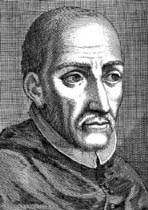Saint Turibius of Mongrovejo
Feast day March 23

Turibius, a member of a wealthy Spanish family in the 16th century, was a brilliant professor of law at Salamanca University. As judge at the court of Inquisition, he dispensed justice. His responsibility and keen insight were praised by Philip II, king of Spain. Unexpectedly, the pope appointed this layman archbishop of Lima, Peru. Turibius argued, for he was not a priest, had not volunteered, and had never been to South America. But the pope sent him anyway. Turibius’s holiness and courage showed in every decision he made. God needed a man who would bring Christ’s teachings to South America. Greedy Spanish conquerors had taken over the land and the people of Peru. Those wealthy landlords were guilty of oppression. In some cases, priests had joined the Spanish leaders in oppressing the people. It was a critical situation that Turibius faced when he rode into Lima, Peru, in 1581.

Upon his arrival, Turibius began visiting every parish and mission in his diocese. This took seven years. He traveled thousands of miles. His journeys were dangerous because he went alone through areas plagued by wild animals and a variety of diseases. Sometimes he went two or three days without food or a bed. The condition of the native people horrified Turibius. Thousands of baptized people had little idea of Christianity because there were no catechisms or Bibles in their languages and no priests for their missions.
Turibius gathered the bishops for the Third Council of Lima. They decided to print catechisms in the native languages, to set up classes for those in need, to regulate the sacraments, and to reform the priests. Turibius was firm, though understanding. He set an example by learning the indigenous languages. He spent his life baptizing and confirming, building hospitals, and establishing the first seminary in the new world. Turibius was an old man, visiting a mission when he fell sick. He dragged himself into a church in Lima, begged for the Sacrament of the Anointing of the Sick, and then died.
Suggestions
-
Have the students compare the lives of Turibius and Archbishop Oscar Romero.
-
Let the class compile a scrapbook of Mexican, Central American, and South American saints, such as Saint Turibius, Saint Rose of Lima, Saint Martin de Porres, and Saint Peter Claver.
-
Play music and show art from Mexico, Central America, and South America.
Excerpted from Christ Our Life, by Sisters of Notre Dame of Chardon, Ohio
Image credit: Saint Turibius of Monogrovejo by unknown artist, 2006. Public Domain via Wikimedia.

